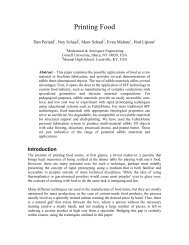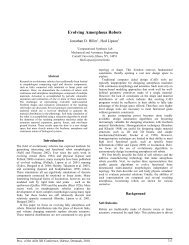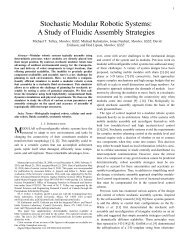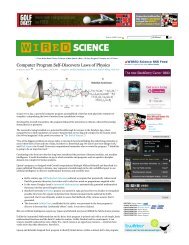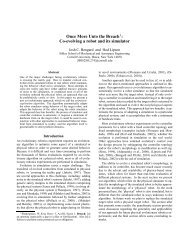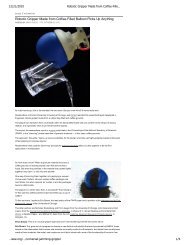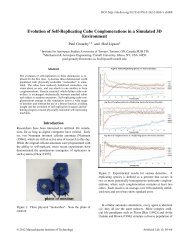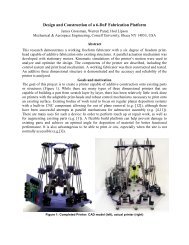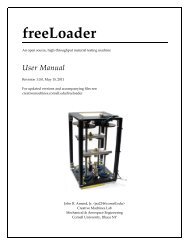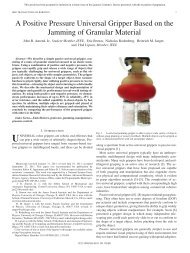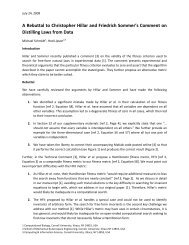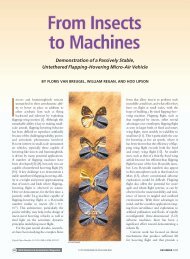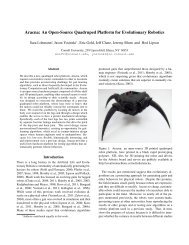Multi-material Freeform Fabrication of Active Systems - Cornell ...
Multi-material Freeform Fabrication of Active Systems - Cornell ...
Multi-material Freeform Fabrication of Active Systems - Cornell ...
You also want an ePaper? Increase the reach of your titles
YUMPU automatically turns print PDFs into web optimized ePapers that Google loves.
combinations which result in functional IPMCs which when<br />
hydrated release themselves from the load contacts while<br />
maintaining signal contact, yet have low contact resistance with<br />
the load contacts. Thus far, we have freeform fabricated test<br />
housings, and then manually cast variants <strong>of</strong> IPMC <strong>material</strong>s<br />
into these housings, and tested these partially freeform<br />
fabricated relays using a PC-based data acquisition system.<br />
Given our success with complete freeform fabrication <strong>of</strong> IPMC<br />
actuators, this manual casting for expediency during testing<br />
should not be considered evidence <strong>of</strong> any additional difficulty<br />
in automating the casting for this application.<br />
Current [A]<br />
0.02<br />
0.01<br />
0<br />
-0.01<br />
Stimulus Current vs. Time<br />
-0.02<br />
0 50 100<br />
Elapsed Time [s]<br />
Load Path Resistance vs. Time<br />
150 200<br />
Load Path Resistance [Ohm]<br />
10 3<br />
10<br />
0 50 100 150 200<br />
2<br />
Elapsed Time [s]<br />
Figure 10. Successful test <strong>of</strong> partially freeform fabricated relay;<br />
IMPC input signal 1.2V, 0.05Hz square wave, V Load = 1.2VDC<br />
These partially freeform-fabricated relays achieved a<br />
controllable load path resistance change <strong>of</strong> a factor <strong>of</strong> two at<br />
switching frequencies up to 0.05 Hz with a 1.2V control input<br />
and an RMS input current <strong>of</strong> 3.8mA (Figure 10). At 1.2V load<br />
potential, load/input current gain is roughly 1.05. The device<br />
functions above 1Hz, but current gain falls below 1.<br />
4. THE FAB@HOME PROJECT<br />
Future fabricator systems that can produce complex functional<br />
artifacts comprising many <strong>material</strong>s will transform the way we<br />
design, make, deliver and consume some products, and enable<br />
the creation <strong>of</strong> entirely new products that will be literally<br />
impossible to produce otherwise.<br />
Unfortunately, the key to these future fabbers, SFF<br />
technology, is trapped in a “chicken and egg” paradox, in<br />
which having only niche applications keeps SFF technology<br />
expensive and little known, and being expensive and little<br />
known, few new applications for SFF systems are developed,<br />
and the demand for SFF systems is too small to reduce their<br />
cost.<br />
In order to escape this paradox, and to accelerate the spread<br />
and development <strong>of</strong> personal fabrication technology, we have<br />
developed the Fab@Home Project, and an open-source, lowcost,<br />
personal fabricator system kit, which we call the<br />
“Fab@Home Model 1” (Figure 11(a)). Our project has been<br />
inspired by the open-source approach employed by Bowyer’s<br />
RepRap Project [23] toward the goal <strong>of</strong> developing selfreplicating<br />
fabbers. The aim <strong>of</strong> our project is to put SFF<br />
technology into the hands <strong>of</strong> the maximum number <strong>of</strong> curious,<br />
inventive, and entrepreneurial individuals, and to help them to<br />
drive the expansion and advancement <strong>of</strong> the technology.<br />
18.5”<br />
(47 cm)<br />
16”<br />
(41cm)<br />
18”<br />
(46cm)<br />
(a) (b)<br />
Figure 11. The Fab@Home Model 1 Design. (a) 3D CAD model <strong>of</strong><br />
an assembled Model 1; (b) An example <strong>of</strong> assembly instructions<br />
available via the project website<br />
The Model 1 kit has a parts cost <strong>of</strong> roughly $2300, includes<br />
a free, open-source application to control the fabber, requires<br />
only basic hobbyist tools and skills to assembly and use, and<br />
can be used to deposit almost any room-temperature liquid or<br />
paste. It is essentially a simplified version <strong>of</strong> our research<br />
platform, but uses only a syringe deposition tool, and is slower<br />
and has lower resolution. We have used Model 1 machines to<br />
make multi<strong>material</strong> objects, and it could certainly be used to<br />
make most <strong>of</strong> the functional devices that we have produced<br />
with our research platform.<br />
We have endeavored to make obtaining, assembling, using,<br />
and experimenting with the Model 1 as simple and intuitive as<br />
possible – the website provides step-by-step ordering, assembly<br />
(Figure 11(b)) and operational instructions, and the application<br />
has an animated graphical user interface (Figure 12).<br />
Figure 12. A screenshot from the PC application displaying a<br />
model ready for fabrication and dialog boxes for positioning and<br />
real-time status information<br />
To promote collaborative development <strong>of</strong> the technology,<br />
we have developed a user-editable “wiki” website [24] to<br />
6 Copyright © 2008 by ASME



